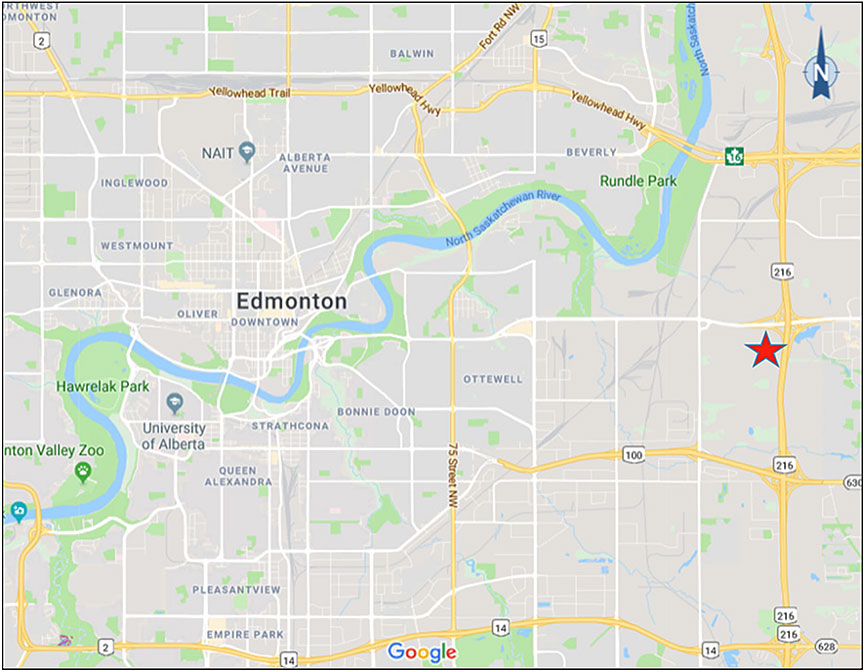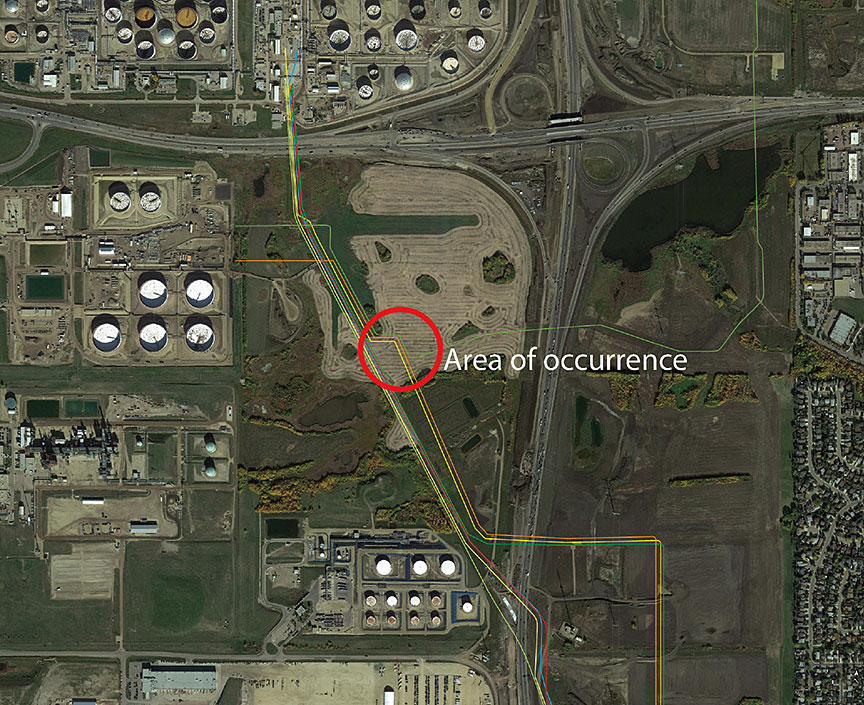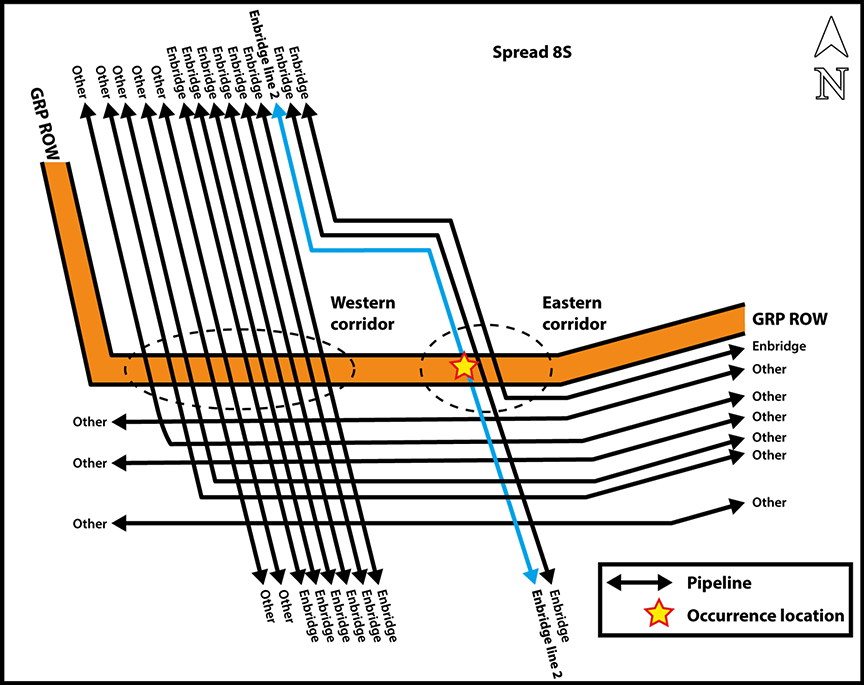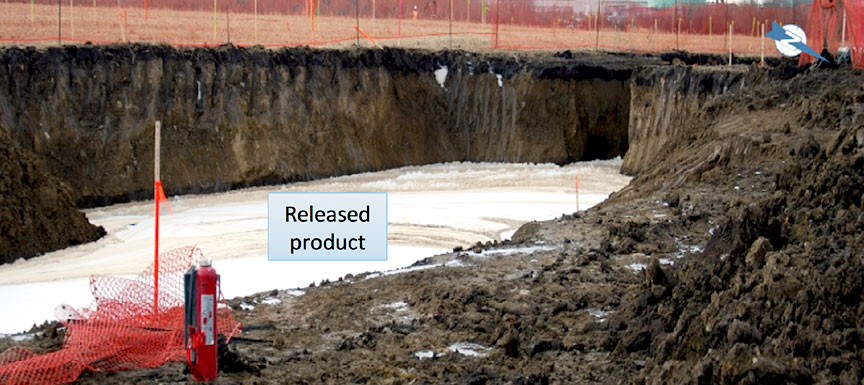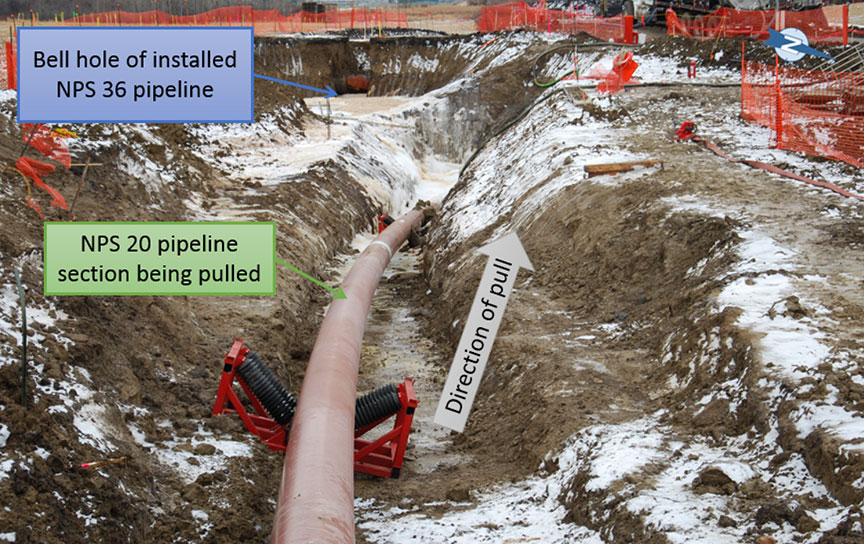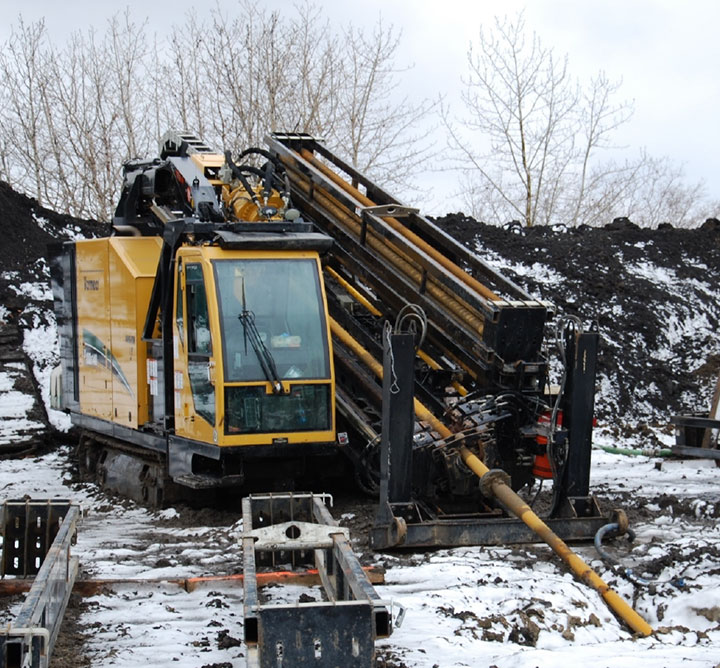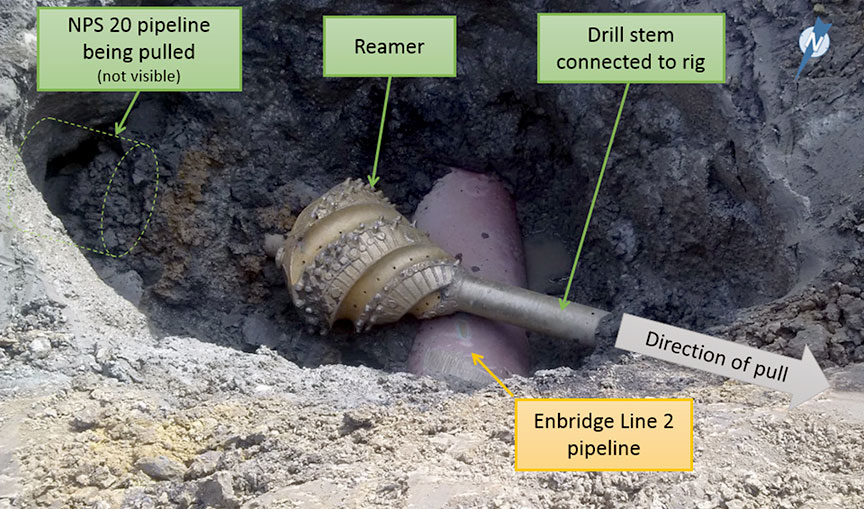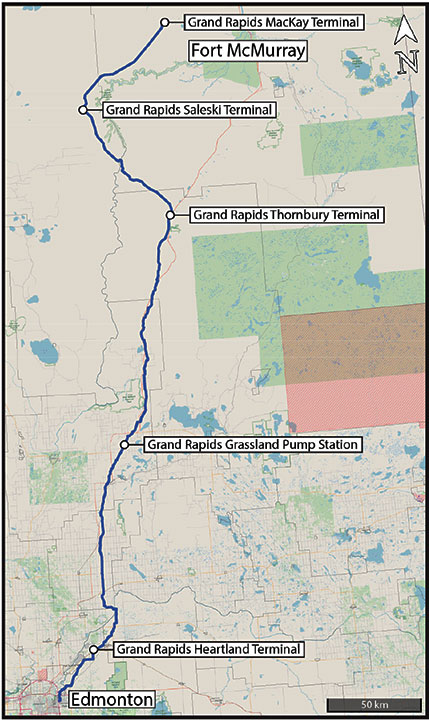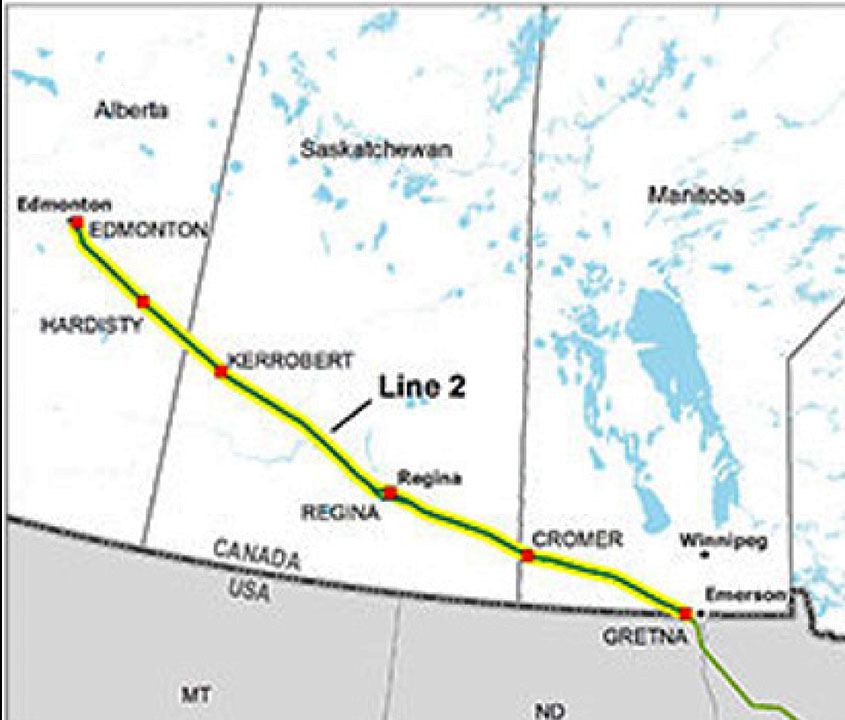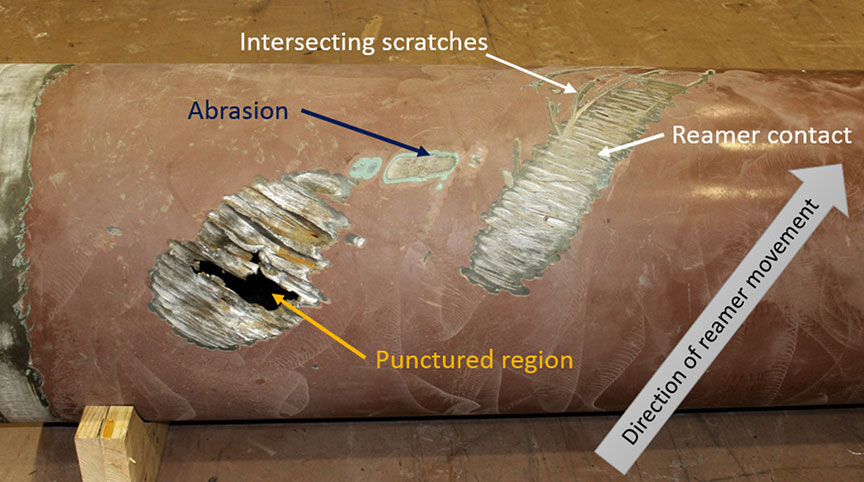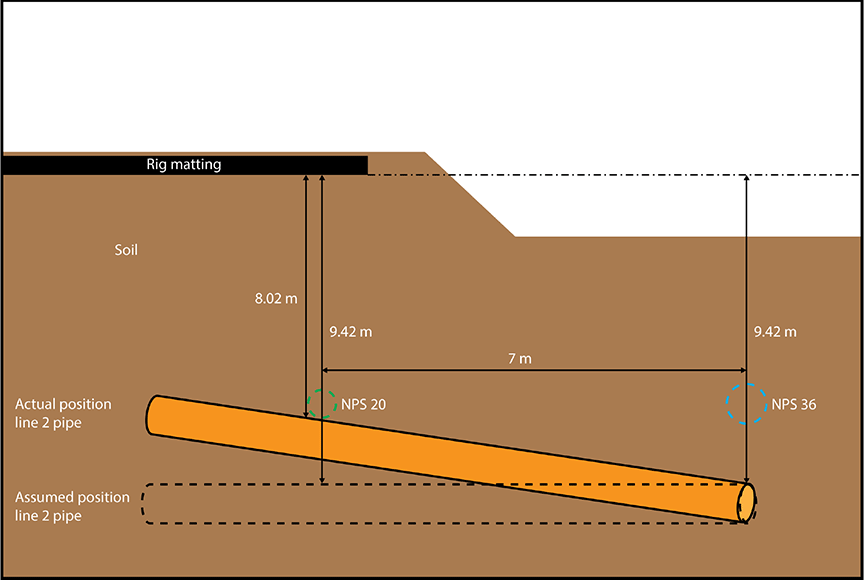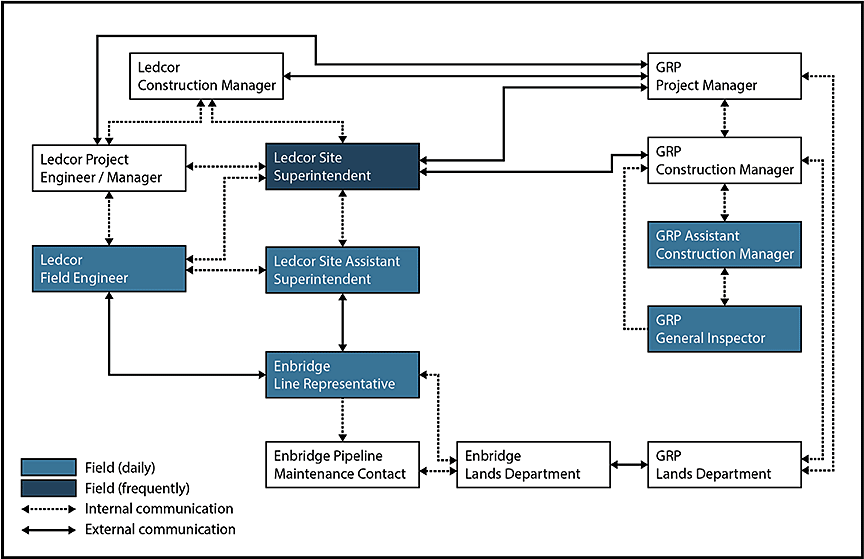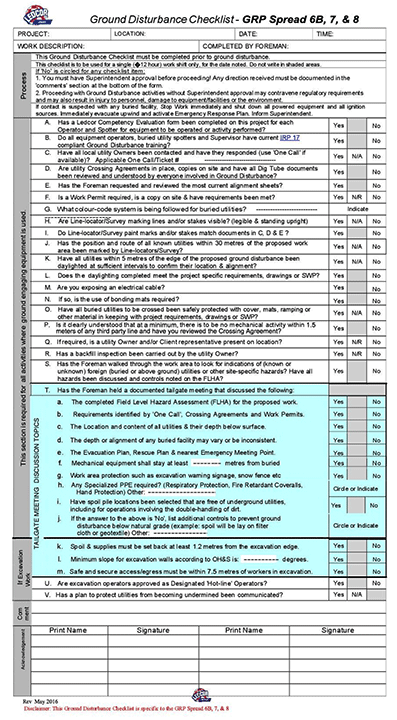Third-party damage to a crude oil pipeline
Enbridge Pipelines Inc.
Line 2
Sherwood Park, Alberta
The Transportation Safety Board of Canada (TSB) investigated this occurrence for the purpose of advancing transportation safety. It is not the function of the Board to assign fault or determine civil or criminal liability. This report is not created for use in the context of legal, disciplinary or other proceedings. See Ownership and use of content. Masculine pronouns and position titles may be used to signify all genders to comply with the Canadian Transportation Accident Investigation and Safety Board Act (S.C. 1989, c. 3).
Summary
On 17 February 2017, at approximately 1505 Mountain Standard Time, a 610 mm (24-inch) pipeline operated by Enbridge Pipelines Inc. was struck and punctured by a 28-inch reamer during the installation of a Grand Rapids Pipeline GP Ltd. pipeline. Approximately 1000 m³ of petroleum crude oil condensate was released into an excavation in the vicinity of the occurrence, saturating the soil. Most of the released product was recovered. There were no injuries, and no off-site evacuation was required.
Le présent rapport est également disponible en français.
1.0 Factual information
On 15 February 2017, a section of a new 20-inch (nominal pipe size [NPS] 20) pipeline approximately 200 m in length was being installed for Grand Rapids Pipeline GP Ltd. (GRP Ltd.).Footnote 1 The pipe was being laid in a pipeline corridor located in a petrochemicals industrial area in Sherwood Park, Alberta (Figure 1), and was part of the new Grand Rapids Pipeline (GRP) system.Footnote 2
The pipe was being installed using a horizontal directional boring (HDB) technique.Footnote 3 The installation involved crossing several other operating pipelines, including 9 pipelines owned by Enbridge Pipelines Inc. (Enbridge).Footnote 4
1.1 The occurrence
At 1504:42Footnote 5 on 17 February 2017, Enbridge Control Centre Operations (CCO) received a series of supervisory control and data acquisition alarms for its Line 2 pipeline, an operating 24-inch liquid hydrocarbon pipeline. The alarms included indications of sudden pressure drop and increase of flow. CCO operators immediately started a review and assessment of the alarms in accordance with established procedures.
At approximately 1510, at the GRP excavation site, a liquid was observed coming out of the exit point of the HDB operation. The liquid had characteristics consistent with liquid hydrocarbons. At that time, the NPS 20 pipeline was being pulled through the bored hole. Work was immediately stopped. An evacuation to the designated muster stations was initiated.
At about the same time, the Enbridge CCO operators completed the assessment of the alarms, determining that an integrity breach of Line 2 had likely occurred. The CCO operators then activated the established pipeline shutdown procedure. At 1510:49, the stop line command for Line 2 was initiated. The shutdown and isolation of Line 2 was completed at 1518:54.Footnote 6
From 1510 to 1515, personnel at the occurrence site assessed the situation and activated the site emergency response plan.
Field personnel confirmed the presence of liquid hydrocarbons in the HDB excavation area. Ledcor Pipeline Limited (Ledcor)Footnote 7 personnel notified the Enbridge field representative, who returned to the site at approximately 1520. At 1540, the Enbridge field representative notified Enbridge pipeline maintenance personnel. At 1542, the Enbridge CCO was notified that there had been a release of liquid hydrocarbons.
At approximately 1610, the Enbridge CCO confirmed that the integrity of Line 2 had been breached in the vicinity of the HDB operation.
At approximately 1615, Enbridge's emergency response plan was activated. The incident command system was mobilized at 1629.
By 2030, all regulatory agencies (local, provincial, and federal) had been notified of the occurrence.
The released product, which did not ignite, was contained within an existing excavated area. There were no injuries, and no further evacuation was required. At the time of the occurrence, the sky was clear with light winds, and the temperature was 9 °C.
1.2 Occurrence site
The occurrence site was on land owned by Shell Canada Ltd. (Shell) in the Sherwood Park petrochemicals industrial area (Figure 2).
There were 17 buried hydrocarbon pipelines owned or operated by 6 different companies in the vicinity of the occurrence.
In this area, the GRP right-of-way (ROW) is called spread 8 South (8S), and is a corridor designed to accommodate the GRP system's 36-inch (NPS 36) and NPS 20 pipelines. The installation of these 2 pipelines, which required crossing 14 of the buried pipelines, was being completed as 3 separate HDB operationsFootnote 8:
- installation of a section of the NPS 36 pipeline in the western corridor, crossing 11 pipelines
- installation of a section of the NPS 36 pipeline in the eastern corridor, crossing 3 pipelines
- installation of the NPS 20 pipeline section in the eastern and western corridors, crossing all 14 pipelines
The occurrence site was in the eastern corridor (Figure 3).
In the vicinity of the occurrence, the soil was silty clay till. At a depth of 10.5 m, no groundwater was noted.
Before the HDB operations started, rig matsFootnote 9were placed along the ROW to provide an access ramp over the existing buried pipelines to allow construction vehicles and heavy equipment to circulate there. The rig matting extended over the Enbridge Line 2 pipeline.
1.3 Site examination
At the east end of the corridor, there was a large excavation pit, known as a bell hole,Footnote 10 that was being used for the installation of the 2 GRP pipelines. The released product, approximately 1000 m³ of petroleum crude oil condensate, was contained within the excavation pit (Figure 4). A section of the NPS 20 pipeline that was being pulled through was protruding from the entry point of the HDB operation (Figure 5).
A drilling rig that was in the process of pulling the NPS 20 pipeline section was positioned at the west end of the western corridor (Figure 6).
A reamerFootnote 11 that was being used in the pull-through operation was still in contact with the Enbridge Line 2 pipeline (Figure 7). The pipeline's depth of cover at the contact point was about 8.06 m.
The damaged section of Enbridge Line 2 pipe (approximately 3 m long) was removed and transported to the TSB Laboratory for detailed examination.
1.4 Response to the occurrence
The initial emergency response focused on preventing the released product from igniting. Fire-retardant foam was applied throughout the occurrence site. The cleanup was then focused on recovering the released product.
An air-,Footnote 12 soil-,Footnote 13 and underground water–Footnote 14 monitoring program in the vicinity of the occurrence was implemented in response to the occurrence to monitor for contaminants.Footnote 15 Continuous air monitoring was discontinued on 17 April 2017, as the test results indicated that contaminants were no longer present.
Most of the released product was recovered, primarily by pumping and the use of hydrovac equipment. Removal and replacement of the contaminated soil was completed by 20 July 2017. Site remediation, including soil and groundwater monitoring, is expected to continue until at least 2020.
1.5 The Grand Rapids Pipeline project
The GRP project is a dual pipeline system designed to transport crude oil and diluent between northern Alberta and Edmonton (Figure 8).
An NPS 36 crude oil pipeline will move blended bitumen from northwest of Fort McMurray to the Edmonton market, and an NPS 20 pipeline will move diluent from Edmonton to northwest of Fort McMurray.
GRP Ltd. was the owner of the NPS 36 and NPS 20 pipelines, and was responsible for the design, project management, and monitoring of all construction activities on the dual-pipeline system. It awarded the general construction contract to Ledcor, which in turn subcontracted Jay-Nart Directional Drilling Ltd. (Jay-Nart) for the HDB operations in the spread 8S corridor.
Ledcor responsibilities included the project management and execution of all construction activities related to the GRP pipelines, including oversight of their subcontractors.
1.6 Enbridge's Line 2 pipeline
Enbridge's Line 2 pipeline, a federally regulated pipeline, originates in Edmonton, Alberta, and extends east through Saskatchewan and into Manitoba to the Canada–United States border. Near Gretna, Manitoba, the pipeline interconnects with Enbridge's Lakehead System in the United States (Figure 9).
The Line 2 pipeline was being used primarily to transport light crude oil and medium crude oil, but on occasion was also used to transport petroleum crude oil condensate. The flow rates for this pipeline varied from 1500 m³/h to 2900 m³/h. Line 2 was controlled from the Enbridge CCO in Edmonton.
At the occurrence location, the maximum operating pressure for Line 2, as approved by the National Energy Board (NEB), was 9930 kilopascals (kPa) (1440 psi), with an operating capacity of 56 400 m³ per day.
At the time of the occurrence, Line 2 was transporting petroleum crude oil condensate and was operating at a pressure of 3351 kPa (486 psi) and a temperature of 7.9 °C (46.2 °F).
The segment of pipe involved in the occurrence had been installed in 2015 as part of a pipe replacement project. The pipe was manufactured from a Grade 483 Category I material, in accordance with the Canadian Standards Association (CSA) specification Z245.1-07.Footnote 16 The pipe had a nominal outer diameter of 24 inches and a wall thickness of 10.31 mm. The pipe was coated with a dual-layer fusion-bonded epoxy system.
1.7 Laboratory examination of damaged pipe section
A detailed examination of the damaged section of the Enbridge Line 2 pipe at the TSB Engineering Laboratory determined the following:
- The geometrical dimensions and metallurgical properties of the pipe met the specification requirements. The coating on the undamaged portion of the pipe was in good condition.
- On the damaged portion of the pipe, scratches and some abrasions were present. The scratch depths and widths were consistent with the size of reamer tooth tipsFootnote 17 (Figure 10).
- The damage in the region of the reamer contact had no through-wall holes. The pattern and profile of the intersecting scratches indicated that the rotating reamer was moving toward the west, in the direction of the pull.
- Much deeper penetration of the reamer teeth into the pipe wall had occurred in the punctured region of the pipeline. Some local deformation (inward depression of the pipe wall) was present in this area. The pipe wall was perforated, with 1 larger hole and 2 smaller holes. The direction of the reamer movement was consistent with the region of the reamer contact.
- Several abrasion spots were present on the pipe. Some of these abrasion spots were through the coating into the pipe steel, while others were only within the coating thickness.
- No other flaws were found with the pipe.
1.8 Horizontal directional boring
The installation of a pipeline by HDB is done in multiple stages.
After excavating entry and exit bell holes and setting up the drilling rig, the 1st stage of the HDB consists of drilling a small-diameterFootnote 18 pilot hole. The pilot hole begins at the entry bell hole, follows the designed drill path, and terminates at the exit bell hole. Drilling fluid is used during this process to lubricate the drill stem, evacuate debris, and help stabilize the drill hole, reducing the potential for collapse.
In the 2nd stage, reamers are used to enlarge the pilot hole to a diameter appropriate for the pipeline being installed.
The 3rd stage consists of attaching the preassembled pipeline section to a reamer using a swivel attachment and pulling the pipe through the enlarged hole.
Locating and guiding the drill head is an important part of the drilling operation, because the drill head is underground and therefore not visible from the surface. Some operators use a walk-over locating systemFootnote 19 in which a transmitter installed in the drill head provides depth, pressure, and pitch information that is transmitted by electromagnetic signal through the ground to a receiver above the drill head at the surface. Steering directions based on the transmitted information and the proposed drill path are relayed to the bore machine operator. Each time the drilling operation is paused (such as when changing drill rods or crossing foreign utilities), the location of the drill head is recorded.
Sight holes are the primary and preferred method of confirming the actual drill path. This method requires holes to be excavated, usually by hydrovac, along the designed drill path at a depth that will allow the field team to confirm the actual path.Footnote 20 If necessary, the drilling process would be stopped and the drill path adjusted to ensure adequate separation.
1.8.1 Crossing buried utilities
When performing HDB operations, the drilling rig operator must have full knowledge of all existing utilities along the planned bore path to avoid damage. The exact location of all foreign utilities (pipelines) to be crossed must be confirmed before drilling. This is primarily done by exposingFootnote 21 (daylighting) each pipeline to verify its location and depth.
In cases where daylighting cannot provide visual confirmation of foreign utilities being crossed (for example, under bodies of water, highways, or railway tracks), an alternative method can be used—such as depth calculations based on known points along the foreign utility, which are then cross-referenced to as-built drawings.
An HDB operation can proceed once the depth and location of all foreign utilities have been confirmed, but approval from each owner is required before the utility can be crossed. A representative of each owner is typically present during the crossing operation to help locate the utility and ensure that crossing agreement conditions are met.
1.9 Regulatory requirements for ground disturbances
The NEB regulates activities such as excavation and drilling (including HDB) that can cause a ground disturbance in and around pipelines under federal jurisdiction.Footnote 22 The NEB provisions require any person planning to engage in an activity that would cause a ground disturbance, or any person constructing a facility near a pipeline, to perform a series of activities, including the following:
- obtain written consent from the pipeline company before engaging in the ground disturbance activity, and accept any conditions set out in the consent document;
- make a site locate request;
- expose all crossings at the point of crossing, or use a method to confirm the pipe's exact location;
- ensure that the work is carried out in accordance with the technical details that are set out in the written consent as accepted by the pipeline company;
- seek and obtain pipeline company approval each time there is a change to the design, location, or type of ground disturbance activity to be performed; and
- comply with all instructions provided by the pipeline company and its authorized field representative.
Based on these regulatory provisions, written crossing agreements between Enbridge and GRP Ltd. were put in place in relation to the spread 8S corridor. These crossing agreements included the following conditions:
- GRP Ltd. must inform its contractors of NEB and Enbridge requirements associated with the crossing agreement.
- Every Enbridge pipeline that will be crossed by any GRP pipeline is required to be located and identified before the ground disturbance activity (excavation or HDB) begins.
- Every Enbridge pipeline being crossed must be exposed using a non-destructive excavation method (hand digging or hydrovac) before performing HDB work within 3 m of the pipe. In situations where a non-destructive excavation method cannot be used, the exact location of the pipeline must be confirmed using an approved alternative method.
- The Enbridge line representative must be on site during the crossing.Footnote 23
- Minimum separation distances must be maintained between the line being installed and the line being crossed, depending on the method of installation.
- All requirements as outlined in the NEB Damage Prevention Regulations must be adhered to.
- Any amendments to the crossing agreement due to changes in the site conditions require agreement from Enbridge prior to work.
During the GRP project, when a non-destructive excavation method could not be used in the field to confirm the exact location of a pipeline being crossed, the following alternative method was to be followed:
- The construction contractor initiates a deviation request and submits it to the GRP Ltd. Lands Department.
- The GRP Ltd. lands team requests as-built information from the owner of the pipeline being crossed.
- The as-built data is verified by exposing, using a non-destructive method, the pipeline being crossed at an alternate accessible location near the crossing site and measuring its position and depth.
- The exact location of the pipeline being crossed at the location of the crossing is validated and confirmed.
- The owner of the pipeline being crossed is required to approve the process used to achieve positive confirmation of the location of the pipeline being crossed.
1.10 Installation of the Grand Rapids Pipeline GP Ltd. pipelines in the spread 8 South corridor
1.10.1 Construction plans for the NPS 36 and NPS 20 pipelines
As part of the GRP construction plan for the spread 8S corridor, crossing agreements were developed with the owner of each foreign utility to be crossed. For the spread 8S corridor, 8 federally regulated Enbridge pipelines were to be crossed during the installation of the NPS 20 and NPS 36 pipelines. For these 8 pipelines (including the Line 2 pipeline), 2 crossing agreements between GRP Ltd. and Enbridge had been developed. These crossing agreements included the following:
- the legal land description for the crossings
- the location plan and profile drawings
- installation method(s)
- additional specific terms and conditions
- crossing dates
- applicable NEB regulations
Once the crossing agreements were signed, preparation for construction at the spread 8S site began. This work included installing the rig mats on the GRP ROW to provide an access ramp for construction vehicles and heavy equipment. In addition, the area along the eastern corridor required the rig mats to be extended over the NPS 20 alignment to allow excavation equipment access to the NPS 36 alignment as part of the open-trench installation. The placement of these extended rig mats was designed so that they could be removed once the open-trench construction of the NPS 36 was complete.
1.10.1.1 Crossing agreement between Grand Rapids Pipeline GP Ltd. and Enbridge Pipelines Inc.
On 19 July 2016, GRP Ltd. submitted an application to Enbridge seeking approval to cross the company's 8 federally regulated pipelines within the spread 8S corridor.
On 13 October 2016, a revised plan and profile of the NPS 36 crossings was submitted to Enbridge, detailing an open-trench method for the eastern corridor.
On 29 November 2016, Enbridge issued the signed crossing agreement to GRP Ltd. after Enbridge's Land Services Department reviewed and approved it.
The signed agreement stated that the NPS 36 and NPS 20 pipelines were to be installed in 2 segments (i.e., the western corridor and the eastern corridor). The western corridor segment was to be installed using HDB, and the eastern corridor segment was to be installed using an open-trench method.Footnote 24
The crossing agreement contained 3 profile drawings, which specified the proposed drill path of the 2 GRP Ltd. pipelines. The western corridor contained a profile drawing for the proposed NPS 36 pipeline and a profile drawing for the NPS 20 pipeline. The eastern corridor contained a profile drawing for the crossings involving the NPS 36 pipeline. GRP Ltd. developed one profile drawing for the eastern corridor, as the method of installation was to be open trench for both GRP pipelines.Footnote 25 As a result, there was no crossing profile drawing for the crossings in the eastern corridor involving the NPS 20 pipeline included in the crossing agreement.
The crossing agreement specified that the 2 GRP Ltd. pipelines would be installed in the lower position below 6 of the 8 Enbridge pipelines, and in the upper position above the other 2 Enbridge pipelines, which were considered to be "deep." One of the "deep" pipelines was Enbridge's Line 2.
The agreement also specified that there would be a minimum separation of 1 m between facilities using the HDB installation method. Further, the Enbridge line representative had the authority to stop work at any time if there was a concern about pipeline integrity or damage to Enbridge facilities or equipment.
1.10.2 Installation of the NPS 36 pipeline
The first segment of the NPS 36 pipeline was successfully installed using HDB in the western corridor on 23 January 2017. All 11 foreign pipelines that had been crossed in this corridor, including the 8 Enbridge pipelines, had been exposed (daylighted) by hydrovac before crossing and their location had been confirmed, in keeping with the applicable procedures.
When the eastern corridor was excavated to prepare for the installation of the second segment of the NPS 36, the depth and location of the 3 Enbridge pipelinesFootnote 26 to be crossed were measured using hydrovac. When these measurements were compared to the corresponding values in the crossing agreement, a number of variances were noted with the depth as well as the diameter of the pipelines to be crossed (Table 1).
| Pipeline | Depth (m) | Diameter (NPS) | Notes / Field observations | ||
|---|---|---|---|---|---|
| Crossing agreement | Actual | Crossing agreement | Actual | ||
| Enbridge Line 2 pipeline | 11.3 | 9.42 | No pipe diameter was indicated | 24 | Pipeline visually appeared to be horizontal |
| Enbridge Edmonton to Hardisty pipeline | 2.7 | 5.3 | 20 | 36 | Actual pipe diameter larger than indicated |
| Enbridge Woodland Pipeline extension | 1.5 | 1.9 | 36 | 36 | N/A |
Based on the field-measured values, it was established that the open-trench method would not be suitableFootnote 27 for this installation, and that proceeding with an HDB would be a safer method of installation. This issue was identified by Ledcor. It was determined that a deviation from the original plans would be needed, which would require amending the crossing agreement.
1.10.2.1 Amendments to the crossing agreement
When original construction plans are modified, any resulting impact on the crossing of foreign utilities must be identified, and the corresponding crossing agreement must be amended.
For the GRP project, the GRP Ltd. Lands Department developed amendments to crossing agreements with support from the engineering group as required. The request for an amendment was then submitted to the owner of the utility being crossed for review and approval.
In this occurrence, GRP Ltd. requested a series of amendments to the crossing agreement for the 8 federally regulated Enbridge pipelines in the spread 8S corridor in January 2017.
There were no specific procedures for amending crossing agreements. The amendment requests consisted of a series of emails that GRP Ltd. and Enbridge exchanged between 17 January and 26 January 2017 (Appendix A).
In one of those emails (dated 23 January 2017), GRP Ltd. asked Enbridge for permission to install the NPS 20 and NPS 36 pipelines in the eastern corridor using HDB (i.e., instead of open trench, as per the original agreement). However, that email was a continuation of a previous email threadFootnote 28 that originally referred to the NPS 36 pipeline only. As a result, Enbridge granted permission, intending it to be only for the NPS 36 pipeline. However, GRP Ltd. interpreted the approval to also cover the NPS 20 pipeline. The approved amendment, in the form of emails, was attached to the original crossing agreement. (See Appendix A for details.)
The amendment to the crossing agreement was completed in accordance with the applicable regulatory requirements.
Table 2 presents a summary of the installation methods for the 2 GRP pipelines that were approved in the original agreement and a subsequent amendment in January 2017.
| GRP project installation method | NPS 36 | NPS 20 | |||||
|---|---|---|---|---|---|---|---|
| Original agreement | Amendments (GRP and Enbridge's understanding) | Actual | Original agreement | Amendments (GRP's understanding) | Amendments (Enbridge's understanding) | Actual | |
| Western corridor | Bore | No change | HDB – west to east | Bore | No change | No change | HDB – west to east (continuous) |
| Eastern corridor | Open trench | Bore | HDB – east to west | Open trench | Bore | No change | |
The installation methods for the eastern and western corridors of both the NPS 36 and NPS 20 pipelines were identified as being the same (i.e., HDB). The NPS 36 pipeline was to be installed using 2 separate HDB bores, whereas the NPS 20 pipeline was to be installed using a single bore through both corridors. On 04 February 2017, the HDB installation of the NPS 36 pipeline in the eastern corridor was successfully completed.
1.10.3 Installation of the NPS 20 pipeline
The NPS 20 pipeline was the final segment of pipeline to be installed in the spread 8S corridor. This installation involved a section of pipeline approximately 200 m long that would cross 14 foreign pipelines.
1.10.3.1 Planning the installation of the NPS 20 pipeline
Ledcor developed an execution plan that included the provisions of the crossing agreements. GRP Ltd. reviewed and accepted the plan. According to the plan, before the start of and during the HDB operation, the following activities were required to be completed:
- Excavate sight holes by hydrovac along the designed drill path at the selected locations to be used to confirm the actual drill path.
- Expose by hydrovac every foreign pipeline along the designed drill path to be crossed, and confirm its actual depth of cover.
- Halt the drilling operation a few metres before each foreign pipeline crossing is reached.
- The owner of the pipeline grants permission to proceed.
During the excavation of the sight holes and the daylighting of the pipelines to be crossed, rig mats extended over the Enbridge Line 2 pipeline. Hydrovac could not be done at this location if the mats were not removed.Footnote 29
The work to daylight and confirm the depth of cover for the pipelines to be crossed by NPS 20 had begun in mid-January 2017. However, with the presence of the rig mats, the Enbridge Line 2 pipeline was not daylighted, and its depth of cover was not measured or recorded at the proposed NPS 20 alignment location.
On 24 January 2017, the depths of cover values for the foreign pipelines to be crossed by the NPS 20 pipeline were reviewed and documented by the Ledcor field engineer.Footnote 30 This information was included in the project's "cut sheet,"Footnote 31 which was then provided to Ledcor's project engineerFootnote 32 by email.
The Ledcor field engineer did not have a field-measured value for the depth of cover of the Enbridge Line 2 pipeline at the NPS 20 crossing. However, the field engineer was aware that the depth of Line 2 at the NPS 36 crossingFootnote 33 (9.42 m) had been measured in the field. Also, when the Line 2 pipeline was daylighted at that location, field team members had noted that it appeared to be horizontal. Figure 11 illustrates the profile of Enbridge's Line 2 pipeline in the vicinity of the GRP ROW.
Figure 12 provides a side-cut view of the actual position of the Line 2 pipeline, compared with the assumed position based on the depth of cover at the NPS 36 crossing.
Based on the information available, the field engineer noted no inconsistencies. Therefore, the depth of Line 2 that had been measured during the installation of the NPS 36 pipeline was selected and transcribed in the cut sheet. The NPS 20 cut sheet was sent to the Ledcor project engineer with an email describing Enbridge Line 2 as "found" and the elevation "confirmed." The Ledcor field engineer had highlightedFootnote 34 the value on the cut sheet to indicate that it had not been verified in the field. Identifying a deviation in the field was not an established process at Ledcor.
To establish the final drill path for the NPS 20 pipeline, the Ledcor project engineer reviewed the cut sheet. Noting the highlighted value, the Ledcor project engineer assumed that this had been done to emphasize that there was a significant difference between the reported Line 2 depth of cover at the planned crossing location and the value in the original crossing agreement. No further verification or confirmation was made. The cut sheet was sent to the GRP project team for further review and acceptance in preparation for finalizing the NPS 20 drill path.
Between 24 January and 15 February 2017, the Ledcor field engineer, the Ledcor superintendent, the Ledcor assistant superintendent, and the Enbridge line representative discussed the impact of the ramp on the Line 2 depth verification. However, no deviation request was made. An alternative method to positively confirm the exact location and depth of cover for the Line 2 pipeline was not applied.
1.10.3.2 Execution of horizontal directional boring for the NPS 20 pipeline
In preparation for the HDB operation, the entry and exit bell holes for the NPS 20 pipeline were excavated at the east and west ends of the proposed bore path in the spread 8S corridor. The drill rig was set up at the west end. The drill path had been designed based on data that Ledcor provided as part of the HDB execution plan for the NPS 20 pipeline. The required sight holes had been excavated, and all pipelines to be crossed—except for the Enbridge Line 2 pipeline—had been daylighted as planned.
On 15 February 2017, the drilling of the 7-inch pilot was begun at the west end. As per the execution plan, drilling was halted a few metres before each of the pipelines being crossed was reached, so that permission to proceed could be requested from the pipeline owner.
The Enbridge Line 2 pipeline, which was the 12th pipeline to be crossed, had not been daylighted. When approaching that crossing, the drilling was halted approximately 2 m prior to the crossing, and permission was requested from Enbridge to proceed with the crossing. The Enbridge line representative granted permissionFootnote 35 to proceed with the drilling and take the upper position with respect to the Line 2 pipeline; the pipeline was crossed with no issues. In giving permission to cross the Line 2 pipeline, the Enbridge line representative had assumed that the depth and location of the pipeline as reported in the approved cut sheet had been positively confirmed using an alternative method to daylighting.
Later on 15 February, the drilling of the pilot hole was completed. No abnormal situation was noted, and the actual drilled path was consistent with the designed path.
Over the next 2 days, the pilot hole was enlarged to the size required to accommodate the pull-through of the NPS 20 pipeline. This operation was completed in 2 steps using an 18-inch reamer followed by a 28-inch reamer. During the process, no abnormal readings on the drilling rig instrumentsFootnote 36 were noted.
On 17 February, the day of the occurrence, as part of normal shift-start activities, a ground disturbance checklist (Appendix B) was completed.Footnote 37
The ground disturbance checklist was designed as a "yes" or "no" questionnaire to document whether each required action related to a ground disturbance had been completed. If the response to any item in the checklist was "no," approval from the superintendent was required to proceed.
The ground disturbance checklist included the following items:
- Verification that all crossing agreements are in place.
- The review of the required documentation is completed and understood by everyone involved in the ground disturbance.
- All utilities within 5 m of the planned ground disturbance have been daylighted and their location verified.
- Verification that project specific requirements have been adhered to.
The checklist cautioned that proceeding without this approval could result in injury to personnel or damage to facilities, equipment, or the environment.
On the checklist that was completed on the day of the occurrence, no variances were noted with respect to the items requiring daylighting and confirmation of foreign utility locations.
Later on 17 February, a preassembled section, approximately 200 m long, of NPS 20 pipeline at the east end of the corridor was attached to the 28-inch reamer at the end of the drill stem using a swivel attachment. The pull-through operation was then begun.
At approximately 1505, when the reamer initiated the crossing of the Enbridge Line 2 pipeline, the drilling rig operator noted increased resistance. The operation was stopped. However, the reamer had already contacted the Enbridge Line 2 pipeline.
1.10.3.3 Timeline of the NPS 20 installation in the eastern corridor
Table 3 summarizes the timeline and events relating to the installation of the NPS 20 pipeline.
| Date | Activity |
|---|---|
| 2016-07-19 | GRP Ltd. requested the depth of the Line 2 pipeline within the GRP ROW from Enbridge. |
| 2016-07-29 | Enbridge replied to GRP Ltd.'s request, indicating an approximate depth of 11.3 m across the GRP ROW for the Line 2 pipeline. |
| 2016-11-29 | Enbridge Land Services Department signed the crossing agreement. |
| 2016-12 | Construction of the access ramp for the spread 8S corridor completed. |
| 2017-01-17 (approx.) |
NPS 36 foreign crossing pipe depth verified by hydrovac. |
| 2017-01-17 | Variances to the crossing agreement regarding pipeline depths and sizes at the NPS 36 crossing locations were identified in the eastern corridor (for the Enbridge Edmonton to Hardisty pipeline and Woodland Pipeline extension pipeline). |
| 2017-01-17 | GRP Ltd. requested from Enbridge an amendment to the crossing agreement for the eastern corridor of the NPS 36 pipeline. The request was to change the position of the NPS 36 pipeline, but still use an open-trench method. |
| 2017-01-19 | Enbridge denied GRP Ltd.'s request to change the position of the NPS 36 pipeline in the eastern corridor. |
| 2017-01-23 | Variances to the crossing agreement regarding the Enbridge Line 2 pipeline depth and size at the NPS 36 crossing locations were identified. GRP Ltd. asked Enbridge for an amendment to the crossing agreement (permission to bore versus open trench). |
| 2017-01-24 | The Ledcor field engineer emailed the Ledcor project engineer, detailing the depth of cover at foreign utilities along the NPS 20 pipeline drill path. |
| 2017-01-24 to 2017-02-15 |
The Ledcor field engineer, Ledcor superintendent, Ledcor assistant site superintendent, and Enbridge line representative discussed the impact of the ramp on the Line 2 depth verification. |
| 2017-01-25 | Enbridge issued approval to GRP Ltd. to bore across 3 Enbridge pipelines (lands descriptions 52-PROP_PL-01, 52-PROP_PL-02, and 52-PROP_PL-03), with 2 conditions (see Appendix A). |
| 2017-01-26 | GRP Ltd. requested and received approval from Enbridge for a variance for one of the conditions in the amendment to the crossing agreement in the eastern corridor approved on 25 January. |
| 2017-01-31 | The Ledcor project engineer confirmed the Ledcor field engineer's cut sheet / drill path before sending it to GRP Ltd. for acceptance. |
| 2017-02-02 | Ledcor submitted the HDB execution plan for the NPS 20 in the spread 8S corridor to GRP Ltd. for acceptance. |
| 2017-02-15 | Drilling of the NPS 20 pipeline was started with the location of the Line 2 pipeline assumed to be horizontal between the NPS 36 and NPS 20 crossing locations in the GRP ROW. |
| 2017-02-15 | The Enbridge line representative allowed the crossing of the Line 2 pipeline to proceed. |
| 2017-02-15 | The 7-inch bore along the drill path for the NPS 20 pipeline was performed. |
| 2017-02-16 | The 18-inch ream along the drill path for the NPS 20 pipeline was performed. |
| 2017-02-17 | The 28-inch ream along the drill path for the NPS 20 pipeline was performed. |
| 2017-02-17 | While the NPS 20 pipe that was attached to the reamer was being pulled, contact occurred at the crossing with the Line 2 pipeline. |
1.11 Personnel involved with foreign utility crossings
In this occurrence, the personnel involved in decision making related to the foreign crossings included the field team and the project team for each company. The field teams consisted of personnel who were in the field during the crossing preparations, the boring, and the final pull for pipelines being installed. The project teams for Ledcor and for GRP Ltd. consisted of personnel who were involved with the day-to-day operations of the project, but were not regularly in the field. Enbridge also had a line representative on site for all ground disturbance construction activities involving its pipelines. The common goal for all parties was to install the pipelines safely by HDB, including safely crossing all foreign utilities. Table 4 and table 5 summarize the roles and responsibilities of the field team and the project team for each company as they pertain to this occurrence.
| Organization | Role | Responsibility |
|---|---|---|
| GRP Ltd. | General inspector |
|
| Assistant construction manager |
|
|
| Ledcor | Field engineer |
|
| Site assistant superintendent |
|
|
| Jay-Nart | Drilling foreman |
|
| Driller |
|
|
| Enbridge | Line representative |
|
| Organization | Role | Responsibility |
|---|---|---|
| GRP Ltd. | Construction manager |
|
| Project manager |
|
|
| Lands Department |
|
|
| Ledcor | Ledcor site superintendent |
|
| Project engineer / manager |
|
|
| Supervisor |
|
|
| Enbridge | Land Services Department |
|
1.11.1 Communications among project team members and the different companies
During the GRP project, a number of regular meetings were held for the project team and the field team to communicate and highlight any project-related issues, including daily meetings pertaining to construction site activities:
- At 0600, a staff meeting was held for Ledcor project staff and the lead field staff.
- At 0630, a staff meeting was held for GRP Ltd. construction staff and field staff.
- At 0700, a combined staff meeting ("tailgate meeting") was held with GRP Ltd. and Ledcor construction staff.
The daily tailgate meeting was documented, and attendance was recorded. The meeting agenda included safety issues and a discussion of upcoming activities for the day. Each team lead would disseminate the relevant information to the respective field teams before they started work.
The Ledcor field engineer was not part of the combined GRP Ltd./Ledcor morning meetings. Instead, the Ledcor site superintendent briefed the field engineer as needed once the morning meetings were complete.
In addition to the daily meetings at 0630 and 0700, the GRP Ltd. project manager attended other project meetings, including a stakeholder meeting with environment, safety, and land groups, a weekly construction meeting with Ledcor, and a weekly meeting with the engineers.
The Enbridge line representative occasionally participated in the field tailgate meeting. However, his participation was not required as part of the GRP Ltd./Ledcor process. No regular meetings or check-ins were scheduled between the Enbridge line representative and the GRP Ltd./Ledcor crossing team. The Enbridge line representative was assigned an Enbridge staff contact to assist with any field concerns that needed Enbridge attention. The Enbridge line representative primarily communicated with project team members through his Enbridge staff contact or through the Ledcor field engineer. After each successful crossing of an Enbridge pipeline, the line representative sent the completed crossing report to the Enbridge Land Services Department.
Figure 13 shows the lines of communication between the primary crossing team members.
1.11.2 Team situational awareness and communication
When people operate in a multi-crew or multi-team environment, team situational awareness (TSA) is important for ensuring safe and effective operations. Effective TSA allows team members to develop accurate expectations for team performance by drawing on a common knowledge base. As individual team members develop a shared understanding of a situation, the team can coordinate what it perceives and decide collectively on a course of action.Footnote 38
TSA is crucial for effective decision making. When teams have a shared understanding of the situation, team members develop a shared understanding of the task, including who is responsible for what as well as what the information needs and requirements are. When TSA is optimal, all the teammates involved can create a true picture of the situation and a more accurate assessment of the risks involved, and can make risk-based decisions.Footnote 39
Effective TSA does not depend on all team members being individually aware, nor does it make sense for everyone to be aware of the same thing at the same time.Footnote 40 Rather, the right information needs to get to the right person at the right time, which involves team coordination.Footnote 41 The effectiveness of the team is often reflected by the degree to which members engage in processes for sharing information (such as questioning, cross-checking, setting up coordination and priorities, and contingency planningFootnote 42).
Communication breakdown can lead to information loss and degraded information sharing within the team, resulting in a negative impact on TSA. Communication failures that can decrease TSA include timing that is too late to be effective, content that is not consistently complete and accurate, incomplete and ambiguous information communicated among team members, the exclusion of individuals in the communication process, and issues that are left unresolved until the point of urgency.Footnote 43
1.12 Regulatory oversight by the National Energy Board
The NEB requires regulated pipeline companies to anticipate, prevent, mitigate, and manage any hazards and risks associated with their operations.
The NEB evaluates regulated companies and their facilities and installations through a risk model to determine appropriate compliance verification activities. This evaluation includes
- identifying potential consequences to people and the environment posed by facilities or an installation based on the products carried, physical properties of the pipe or facilities, and proximity to receptors such as water bodies, environmentally sensitive areas, land use, population density, and presence of workers; and
- reviewing historical information on the company's or operator's management of these consequences collected through previous compliance-monitoring activities.
The NEB uses a number of tools to verify whether companies under its jurisdiction are complying with the National Energy Board Act, regulations, and any project-specific conditions that the NEB has imposed. Audits and inspections are key components of the compliance process; other verification tools include formal compliance meetings, reviews of environmental and emergency management reports and manuals, and the evaluation of emergency response exercises.
1.12.1 Audits and inspections by the National Energy Board
NEB audits are a systematic evaluation of an NEB-regulated company's management system, including programs, practices, procedures, plans, processes, manuals, records, and activities. The objective is to verify a company's compliance with the applicable regulatory requirements—which include a fully developed and implemented management system—and appropriate protection programs in the appropriate areas. Such areas can include damage prevention, emergency management, environment, pipeline integrity, safety, and security. Upon completing the audit, the NEB communicates its findings to the company.
NEB field inspections are on-site, methodical examinations and assessments of a company's regulated activities or operations against specific regulatory requirements. NEB inspections include an assessment of the company's actions pertaining to the specifics of the activities being inspected.
If non-compliances are found following an audit or an inspection, the NEB directs the company to resolve and/or correct all non-compliances within a specified time limit. Companies could also be required to pay a monetary penalty or operate under restricted conditions, or they could be prohibited from operating.
1.12.2 Audit of Enbridge Pipelines Inc.'s third-party crossings program
The NEB's most recent audit of Enbridge's regulated activities began in May 2014, and the final report was released in March 2015.
With respect to the third-party crossings program, the audit report noted the following:
- Enbridge had developed and implemented a crossings program that was addressing the majority, and the most significant, of its hazards, and the majority of its regulatory requirements.
- Enbridge provided evidence that it was applying its Integrated Management System to its crossings program as part of the Land Services Department.
- Non-complianceFootnote 44 findings were grouped into 2 general areas:
- Lack of integration of its crossings program into the overall operational oversight management system processes; and
- Lack of implementation of management system sub-elements consistent with NEB expectations.
The NEB determined that no enforcement actions were immediately required. However, Enbridge was directed to submit a corrective action plan within 30 days to address all identified non-compliances.
In response to the audit report, Enbridge developed, submitted to the NEB, and implemented a corrective action plan that addressed each of the non-compliances identified. At the time of the occurrence, Enbridge had completed all the corrective actions, and the NEB had approved the majority of them.Footnote 45
1.13 Other similar occurrences
Since 2006, there have been 11 other TSB-reportable occurrences involving a pipeline that was struck and that resulted in the release of product (Appendix C). The majority of these occurrences involved construction equipmentFootnote 46contacting a valve component. Three of the 12 occurrences involved an underground pipeline being struck during construction activities.
The TSB investigated a 2007 occurrence in Burnaby, British Columbia (P07H0040). As part of the Burnaby investigation, it was determined that the field location of the Westridge Delivery pipeline was not accurately shown on design drawings. These drawings were based on a 1957 drawing, resulting in an alignment conflict with the trench of the proposed sewer line. As well, because the location of the Westridge Delivery pipeline was not verified in the field as required under the crossing agreement and the National Energy Board Pipeline Crossing Regulations, Part I,Footnote 47 the discrepancy between its location as shown on the design drawings, and its actual field location was not discovered before the start of construction.
1.14 TSB laboratory reports
The TSB completed the following laboratory report in support of this investigation:
- LP045/2017 – Pipe Examination
2.0 Analysis
The operation of the pipeline, the condition of the pipe, and the integrity of the pipeline were not considered contributory to this accident. The analysis will focus on the development of the crossing agreement, amendments to the crossing agreement, construction oversight, and communications between team members and between organizations.
2.1 The accident
The Grand Rapids Pipeline (GRP) project was nearing the completion of the underground nominal pipe size (NPS) 36 and NPS 20 pipeline installations in the spread 8 South (8S) portion of the project. The NPS 36 pipe had been successfully installed, and a 200 m continuous length of the NPS 20 pipe was being installed by horizontal directional bore (HDB). The accident occurred when the NPS 20 pipe for the GRP project was being pulled through a horizontal borehole and the attached reamer struck and punctured Enbridge Pipelines Inc.'s Line 2 pipeline.
As per the execution plan, when approaching the Line 2 pipeline in the eastern corridor, the drilling was halted approximately 2 m before the crossing so that permission to proceed could be requested. The Enbridge line representative granted permission to take the upper position to the Line 2 pipeline. Although approved for drilling, the HDB had proceeded without a field-measured confirmation of the exact location and depth of cover for the Line 2 pipeline at the NPS 20 crossing.
At the surface of the Line 2 pipeline crossing, an access ramp consisting of rig matting, intended for heavy vehicles, extended over the pipeline. In the weeks leading to the start of drilling operations for the NPS 20 pipeline, the Ledcor field team and the Enbridge representative discussed how the visual confirmation of the Line 2 pipeline would be performed. To perform a hydrovac at this location along the NPS 20 ditchline, the local rig matting would first have to be uncovered and removed.
The decision by Ledcor to keep the ramp in place was made after field discussions between Enbridge and Ledcor. Because the access ramp was not removed to daylight the Line 2 pipeline, field measurements to confirm the exact position and depth of cover were not performed.
The Line 2 pipeline had not been daylighted at the NPS 20 crossing. The field engineer was aware that the depth of Line 2 at the NPS 36 crossing, 7 m from the NPS 20 crossing, had been measured in the field. No conflicting information indicated to the field engineer that the Line 2 pipeline would be in the drill path. Furthermore, several field team members had noted that when the Line 2 pipeline was daylighted at the NPS 36 crossing, it visually appeared to be horizontal. Therefore, the depth of cover measurement that had been taken for the adjacent NPS 36 pipeline was used for the NPS 20 crossing.
On the project cut sheet, the assumed depth of cover value was highlighted to signify that it had not been verified in the field. However, highlighting values on a cut sheet to communicate deviations was not an established process at Ledcor. Furthermore, the comments accompanying the project cut sheet submitted to the project engineer described the depth of cover as having been found and confirmed. Therefore, no deviation request was made to Grand Rapids Pipeline GP Ltd. (GRP Ltd.). Upon final acceptance of the project cut sheet, including the incorrect depth of cover value for Line 2 at the NPS 20 crossing, the designed drill path for the NPS 20 pipe was established.
Prior to performing drilling each day, Ledcor required that its ground disturbance checklist be completed. This checklist identified a number of safety defences, including whether all utilities within 5 m of the planned ground disturbance had been daylighted and their location verified. If the response to any item in the checklist was "no," the Ledcor superintendent's approval would be required before drilling could proceed.
On the checklist that was completed on the day of the occurrence, no variances were noted for the items requiring daylighting and confirmation of foreign utility locations. The ground disturbance checklist incorrectly showed that visual depth confirmation had been performed for all pipelines to be crossed. As a result, there was a missed opportunity to further assess the drill path at the Line 2 pipeline crossing.
2.2 Requesting changes and amending crossing agreements
Crossing agreements must be clear and comprehensive. The signed agreement stated that the NPS 36 and NPS 20 pipelines were to be installed in 2 segments (i.e., the western corridor and the eastern corridor). The western corridor segment was to be installed using HDB, and the eastern corridor segment was to be installed using an open-trench method.
While the depths of pipelines in the eastern corridor along the NPS 36 alignment were verified, large variances between the crossing agreement profile depths and the actual field depths were identified. Because of these variances, the field team noted that the crossing plans would need to be amended to minimize the depth and complexity of excavation required. The crossing agreement therefore needed to be revised. Since there were no specific procedures for submitting or reviewing amendments to crossing agreements, GRP Ltd. requested permission from Enbridge by email to use HDB, instead of the open trench method, in the eastern corridor to install both the NPS 20 pipeline and the NPS 36 pipeline.
The email request was made using the same thread of emails in which GRP Ltd. had previously requested an amendment related to the NPS 36 installation. With the use of the existing email thread, the new request was ambiguous regarding which pipeline the requested change referred to (i.e., the NPS 36 pipeline, the NPS 20 pipeline, or both). When Enbridge reviewed the email, it understood the request to be related only to the NPS 36 pipeline. As a result, Enbridge did not request a profile drawing for the NPS 20 drill path in the eastern corridor. The lack of clarity on the email request to amend the crossing agreement resulted in a missed opportunity to identify the potential conflict with the Line 2 pipeline. If detailed procedures for amending crossing agreements are not established and followed, not all pipelines being crossed may be accurately identified, increasing the risk of damaging an operating pipeline during a ground disturbance.
2.3 Sharing critical information about pipeline location
Defined communication channels had been established to allow information to flow between GRP Ltd. team members. Some team members were responsible for providing and communicating information, and others were responsible for evaluating information and making decisions.
Various meetings had been established for crossing team members to communicate and highlight any project-related issues. Despite these regular meetings, a number of communication failures relating to the location of the Line 2 pipeline occurred in the weeks and days prior to the occurrence:
- When the crossing agreements were being developed, GRP Ltd. had requested the profile drawings from Enbridge to design each of the crossings. However, only an approximate depth (11.3 m) for the entire GRP right of way (ROW) was provided. With this single data point, GRP Ltd. was not specifically aware of the slope of the Line 2 pipeline within the ROW.
- The Enbridge line representative was not specifically aware of the pipeline location information that was provided to Ledcor and GRP Ltd. The Enbridge line representative believed that the Ledcor and GRP field staff had a copy of the Line 2 profile drawing and that field depth calculations and location confirmations using this information were being performed.
- The GRP Ltd. project team and the Enbridge Land Services Department were not specifically aware that the rig matting was an issue. As a result, the field decision not to remove the rig matting did not trigger further evaluation of the depth of cover of Line 2.
- Ledcor, Enbridge, and GRP Ltd. field staff were aware that the visual field verification of the Line 2 pipeline location had not been performed prior to the installation of the NPS 20 pipeline. Although there were processes in place for this information to be shared with Enbridge and the GRP project team, not all decision makers at GRP Ltd. and Enbridge were aware of the situation.
GRP Ltd., as owner of the project, was responsible for requesting the most current information available to ensure the accuracy of the crossing design. Any relevant information required to perform the work in the field was to be shared with personnel performing the work. With no process in place for pipeline companies to share their as-built drawings when developing crossing agreements, GRP Ltd. did not receive these drawings. Therefore, GRP Ltd. assumed, based on its early request for information, that the information it had obtained from Enbridge was complete.
All parties involved in the field operations had a copy of the crossing agreement (which included the approved amendments). However, GRP Ltd. and Ledcor were unaware that some of the critical information related to the Line 2 crossing was incomplete, was ambiguous, or had not been obtained during the development of the scope of work for the NPS 20 pipeline. Furthermore, Enbridge was unaware that the other field personnel did not have all the information required to validate the drill path. When the drill path at a pipeline crossing is being determined, if critical information about the location of pipelines being crossed is not obtained and shared with all relevant parties, an incorrect drill path may be established, increasing the risk of damage to the pipeline during HDB.
2.4 Compliance verification of Enbridge Pipelines Inc.
The National Energy Board (NEB) initiated an audit of Enbridge's regulated activities in May 2014, which included a review of the company's third-party crossings program.
The NEB audit found that Enbridge's crossings program was not fully integrated into the company's overall operational oversight management system processes. However, the audit determined that Enbridge had developed and implemented a crossings program that was addressing the majority of—and the most significant of—its hazards. Enbridge has completed corrective actions associated with findings related to the company's third-party crossings program, and the NEB has verified the majority of these.
The NEB's oversight of Enbridge was conducted in a way that was consistent with established regulatory practices.
2.5 Occurrence response
The response of a pipeline operator to any type of leak is always evaluated in determining whether the impact on people and the environment can be reduced. In this occurrence, the Enbridge operations control centre acted within minutes on the leak triggers that its supervisory control and data acquisition system provided. This led to quick decisions by both the operator of Line 2 and the supervisor to shut in the affected pipeline, minimizing the extent of the release. The subsequent field response by Enbridge resulted in the prompt initiation of an environmental assessment and subsequent remediation.
The post-occurrence emergency response and resulting remediation were handled in a timely manner to mitigate the impacts of the release.
3.0 Findings
3.1 Findings as to causes and contributing factors
- The accident occurred when the nominal pipe size (NPS) 20 pipe for the Grand Rapids Pipeline (GRP) project was being pulled through a horizontal borehole and the attached reamer struck and punctured Enbridge Pipelines Inc.'s Line 2 pipeline.
- Although approved for drilling, the horizontal directional boring had proceeded without a field-measured confirmation of the exact location and depth of cover for the Line 2 pipeline at the NPS 20 crossing.
- At the surface of the Line 2 pipeline crossing, an access ramp for heavy vehicles consisting of rig matting extended over the pipeline. Because the access ramp was not removed to explore (daylight) the Line 2 pipeline, field measurements to confirm the exact position and depth of cover were not performed.
- The depth of cover measurement that had been taken for the adjacent NPS 36 pipeline was used for the NPS 20 crossing.
- On the project cut sheet, the assumed depth of cover value for the Line 2 pipeline was highlighted in colour to signify that field verification had not been conducted. However, highlighting values in a cut sheet to communicate a deviation was not an established process at Ledcor Pipeline Limited.
- The accompanying comments submitted to the project engineer with the cut sheet described the depth of cover as having been found and confirmed. Therefore, no deviation request was made to Grand Rapids Pipeline GP Ltd. (GRP Ltd.).
- Upon final acceptance of the project cut sheet, including the incorrect depth of cover value for Line 2, the designed drill path for the NPS 20 pipe was established.
- The ground disturbance checklist incorrectly indicated that visual depth confirmation had been performed for all pipelines to be crossed. As a result, there was a missed opportunity to further assess the drill path at the Line 2 pipeline crossing.
- The lack of clarity on the email request to amend the crossing agreement resulted in a missed opportunity to identify the potential conflict with the Line 2 pipeline.
3.2 Findings as to risk
- If detailed procedures for amending crossing agreements are not established and followed, not all pipelines being crossed may be accurately identified, increasing the risk of damaging an operating pipeline during a ground disturbance.
- If critical information about the location of pipelines being crossed is not obtained and shared with all relevant parties, an incorrect drill path may be established, increasing the risk of damage to the pipeline during horizontal directional boring.
3.3 Other findings
- The National Energy Board's oversight of Enbridge Pipelines Inc. was conducted in a manner consistent with established regulatory practices.
- The post-occurrence emergency response and resulting remediation were handled in a timely manner to mitigate the impacts of the release.
4.0 Safety action
4.1 Safety action taken
4.1.1 Enbridge Pipelines Inc.
After the occurrence, Enbridge Pipelines Inc. took the following actions:
- An internal investigation was initiated to identify the root cause(s) of the occurrence.
- A review was initiated to identify improvements to company procedures and processes.
- Work was initiated to review internal communications as well as to clarify and harmonize technical terminology related to pipeline crossings.
4.1.2 Grand Rapids Pipeline GP Ltd.
Grand Rapids Pipeline GP Ltd. took the following actions after the occurrence:
- An internal investigation was initiated to identify the root cause(s) of the occurrence.
- Work was initiated to help raise awareness and prevent future incidents related to ground disturbances.
- A company-wide hazard advisory was issued regarding ground disturbances and foreign line crossings.
- A revised ground disturbance and foreign line crossing checklist was implemented.
- Procedures were revised to ensure that all contractors meet the requirements of the checklist.
4.1.3 Ledcor Pipeline Limited
Ledcor Pipeline Limited (Ledcor) took the following safety actions after the occurrence:
- Safety stand-down meetings have been held to ensure that identification and awareness of preventative actions have been communicated.
- An independent buried pipeline– and utility–locating service company reviewed the Ledcor ground disturbance program. Based partially on the report, Ledcor continues to improve its ground disturbance program elements.
- The existing ground disturbance checklist has been revised and improved.
- A foreign line crossing checklist has been developed and implemented.
- A procedure deviation process has been developed and implemented. It requires senior leadership to review and approve higher potential risk deviations.
- A subcontractor management standard has been implemented. It includes the following components:
- subcontractor health, safety, and environment (HS&E) management task (safety oversight activities) calendar
- subcontractor pre-mobilization meeting guidelines
- subcontractor work commencement kick-off meeting guidelines
- subcontractor HS&E supervisory tool
- subcontractor HS&E performance review meeting guidelines
4.1.4 National Energy Board
Following the occurrence, the National Energy Board took the following actions:
- The initial cleanup and remedial actions on site were monitored.
- A review of the occurrence was initiated to verify compliance with regulatory requirements and to ensure that adequate corrective, preventive, and safety actions were identified and implemented.
- Follow-up will be conducted on the identified deficiencies in the company's processes that will be remediated using the applicable compliance tools.
- The remedial actions on site will continue to be monitored, and environmental oversight will continue to be provided.
- The development and implementation of Enbridge's process improvements will be monitored to ensure that corrective actions are implemented to prevent the recurrence of similar events.
This report concludes the Transportation Safety Board of Canada's investigation into this occurrence. The Board authorized the release of this report on 20 June 2018. It was officially released on 23 July 2018.
Appendices
Appendix A – Communications regarding the amendment to the crossing agreement
The Grand Rapids Pipeline GP Ltd. (GRP Ltd.) Lands Department and the Enbridge Pipelines Inc. (Enbridge) Land Services Department communicated regarding the amendment to the crossing agreement.
- On 17 January 2017, GRP Ltd. asked Enbridge for permission to take the upper position over the Edmonton to Hardisty line using an open cut method for the nominal pipe size (NPS) 36 line only. The communication was by email, with the subject "URGENT REQUEST: Grand Rapids Requesting Upper Position."
- On 19 January 2017, Enbridge replied, but did not approve taking the upper position over the Edmonton to Hardisty line for the NPS 36 pipeline.
- On 23 January 2017, GRP Ltd. asked Enbridge for permission to bore (using horizontal directional boring [HDB]) instead of using the open trench method. This request was made using the official lands descriptionFootnote 48 ("52-PROP_PL-01 to 52-PROP_PL-03") to refer to the geographical area where the 2 GRP Ltd. pipelines, NPS 20 and NPS 36, would intersect the Enbridge pipelines. The communication was a continuation of the earlier email thread, maintaining the earlier subject line of "URGENT REQUEST: Grand Rapids Requesting Upper Position."
- On 25 January 2017, Enbridge replied, granting approval to bore, with 2 conditions:
- increase the depth below the Edmonton to Hardisty line from the minimum of 1 m up to 2 m; and
- daylight the area above Line 2 to a depth of 1 m below the bottom of the proposed GRP NPS 36 crossing.
- On 26 January 2017, the GRP Ltd. construction manager asked the Enbridge Land Services Department for consent for a variance on the pipeline separation requirements for the NPS 36 (condition 1: to bore through the eastern corridor). The variance was required based on new survey information that had been obtained, indicating that the condition to have 2 m below the Edmonton to Hardisty pipeline would not be feasible.
- On 26 January 2017, Enbridge replied, giving permission to bore provided that a 1 m separation below Enbridge's Edmonton to Hardisty pipeline and 1 m separation above the Line 2 pipeline be maintained.
Appendix B – Ledcor Pipeline Limited's ground disturbance checklist
Appendix C – TSB-reportable pipeline occurrences involving unintentional contact leading to a product release, 2006–2017
| Occurrence number | Date | Pipeline operator | Summary |
|---|---|---|---|
| P06H0053 | 2006-10-06 | TransCanada Pipelines Ltd. | Construction equipment unintentionally struck a valve, causing a product release. |
| P07H0040 | 2007-07-24 | Trans Mountain Pipeline | Construction backhoe unintentionally struck an underground mainline, causing a product release. |
| P07H0049 | 2007-08-15 | Minell Pipeline Limited | A farmer's cultivator unintentionally struck and damaged a valve, causing a product release. |
| P08H0061 | 2008-10-16 | TransCanada Pipelines Ltd. | Construction equipment unintentionally struck a valve, causing a product release. |
| P09H0011 | 2009-03-23 | Westcoast Energy Inc. | A snowmobile unintentionally drove over a receipt point, striking a valve and causing a product release. |
| P09H0087 | 2009-09-30 | 2193914 Canada Limited | Construction equipment unintentionally struck and damaged a valve, causing a product release. |
| P10H0027 | 2010-05-03 | Nova Gas Transmission Ltd. | Construction equipment unintentionally struck a valve, causing a product release. |
| P11H0171 | 2011-12-15 | Enbridge Pipelines (Westspur) Inc. | Construction equipment unintentionally struck a valve, causing a product release. |
| P12H0048 | 2012-03-29 | Nova Gas Transmission Ltd. | Construction equipment unintentionally struck a pipeline component, causing a product release. |
| P13H0033 | 2013-03-13 | Enbridge Pipelines Inc. | A hydrovac truck unintentionally struck a valve, causing a product release. |
| P17H0025 | 2017-05-05 | Plains Midstream Canada | Construction work unintentionally struck an underground pipeline, causing a product release. |
